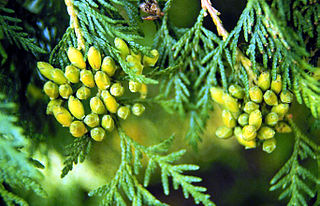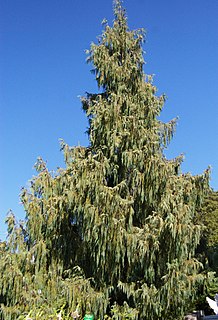
Sequoiadendron giganteum is the sole living species in the genus Sequoiadendron, and one of three species of coniferous trees known as redwoods, classified in the family Cupressaceae in the subfamily Sequoioideae, together with Sequoia sempervirens and Metasequoia glyptostroboides. Giant sequoia specimens are the most massive trees on Earth. The common use of the name sequoia usually refers to Sequoiadendron giganteum, which occurs naturally only in groves on the western slopes of the Sierra Nevada Mountains of California.

Thuja occidentalis, also known as northern white cedar, eastern white cedar, or arborvitae, is an evergreen coniferous tree, in the cypress family Cupressaceae, which is native to eastern Canada and much of the northcentral and northeastern United States. It is widely cultivated as an ornamental plant.

Cupressus cashmeriana, the Bhutan cypress or Kashmir cypress, is a species of evergreen conifer native to the eastern Himalaya in Bhutan and adjacent areas of Arunachal Pradesh in northeastern India. [ Now in vulnerable category, IUCN list retrieved in 2006 ]. It is also introduced in China and Nepal. It grows at moderately high altitudes of 1,250–2,800 metres (4,100–9,190 ft).
Juniperus tibetica, the Tibetan juniper, is a species of juniper, native to western China in southern Gansu, southeastern Qinghai, Sichuan, and Tibet Autonomous Region, where it grows at high to very high altitudes of 2,600–4,800 metres (8,500–15,700 ft). This species may possess the highest elevation treeline in the world.
Scleria afroreflexa is a species of flowering plant in the family Cyperaceae. It is endemic to Cameroon. It grows on mountain grasslands, including areas of grassland in forested regions. It is threatened by the deliberate burning of the grassland habitat. This plant was first collected in 1999.

Scleria terrestris is a species of flowering plant in the family Cyperaceae, the sedges. It is native to much of Asia and Australia, where it is widespread and occasional. It is a rhizomatous perennial herb that grows in wet habitat, such as streambanks and wet mountain understory, and some types of dry and disturbed habitat.
Helicia maxwelliana is a plant in the family Proteaceae. It grows as a treelet up to 3 metres (10 ft) tall. The twigs are dark brown. The flowers are reddish brown. The fruit is black, round, up to 2.5 centimetres (1 in) in diameter. Its habitat is montane forest at 1,600 metres (5,200 ft) to 1,700 metres (5,600 ft) altitude. H. maxwelliana is endemic to Borneo.

Dysoxylum parasiticum, known as yellow mahogany, is a species of rainforest trees in the family Meliaceae. The specific epithet parasiticum is from the Latin meaning "parasitic", referring to the idea that the flowers are parasitic on another tree species.
Scleria biflora is a plant in the family Cyperaceae. It grows as a tufted annual grass.
Scleria bracteata, the bracted nutrush, is a plant in the family Cyperaceae. It grows as a perennial climber.
Scleria dregeana is a plant in the family Cyperaceae. It grows as a perennial herb.
Scleria foliosa is a plant in the family Cyperaceae. It grows as an annual or perennial.
Scleria iostephana is a plant in the family Cyperaceae. It grows as a stout perennial sedge up to 2 metres high.

Scleria mackaviensis is a plant in the family Cyperaceae. It grows as a tufted sedge.
Scleria mikawana is a plant in the family Cyperaceae. It grows as a tall, slender annual sedge.

Scleria reticularis, also known as the reticulated nutrush or netted nutrush, is a plant in the sedge family Cyperaceae.
Scleria robinsoniana is a plant in the nutrush genus Scleria of the sedge family Cyperaceae.

Scleria triglomerata, also known as the whip nutrush, is a plant in the sedge family Cyperaceae.
Scleria vogelii is a plant in the sedge family Cyperaceae. It grows as a stout perennial.








